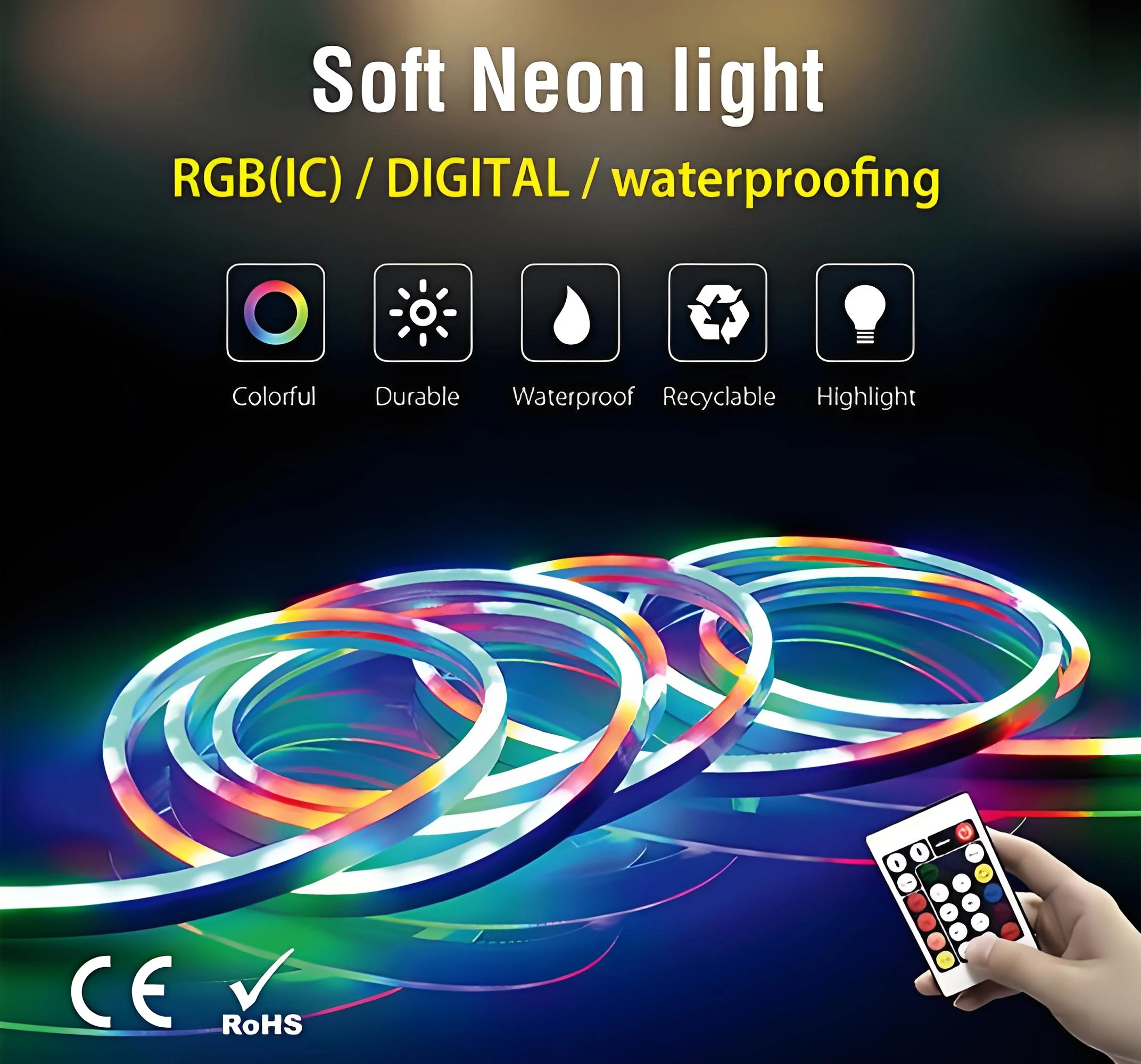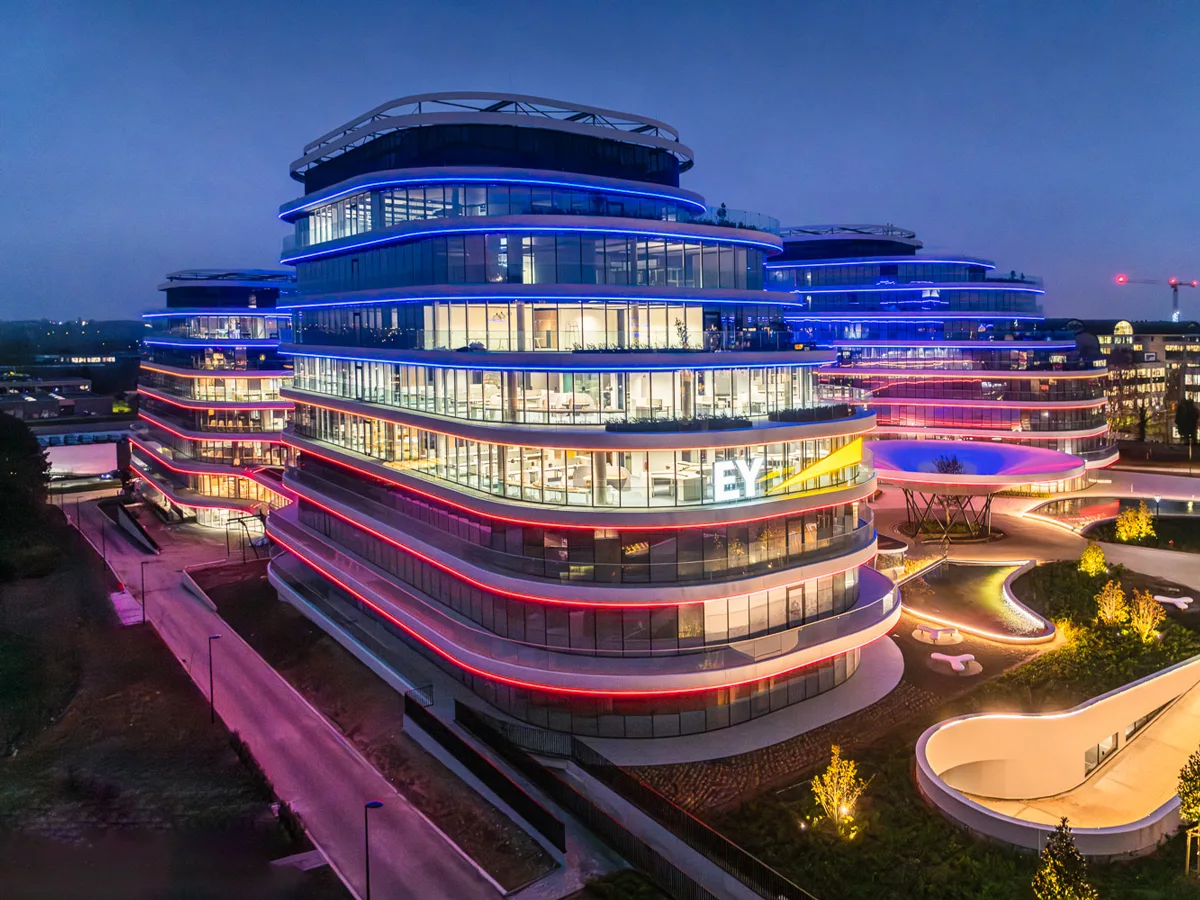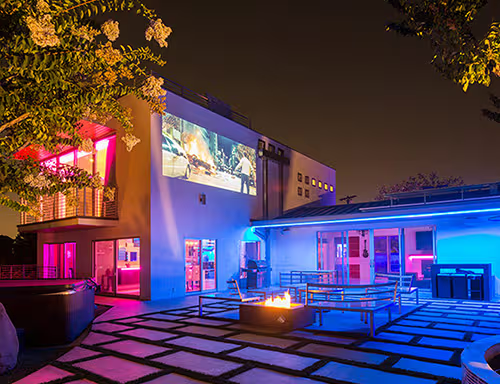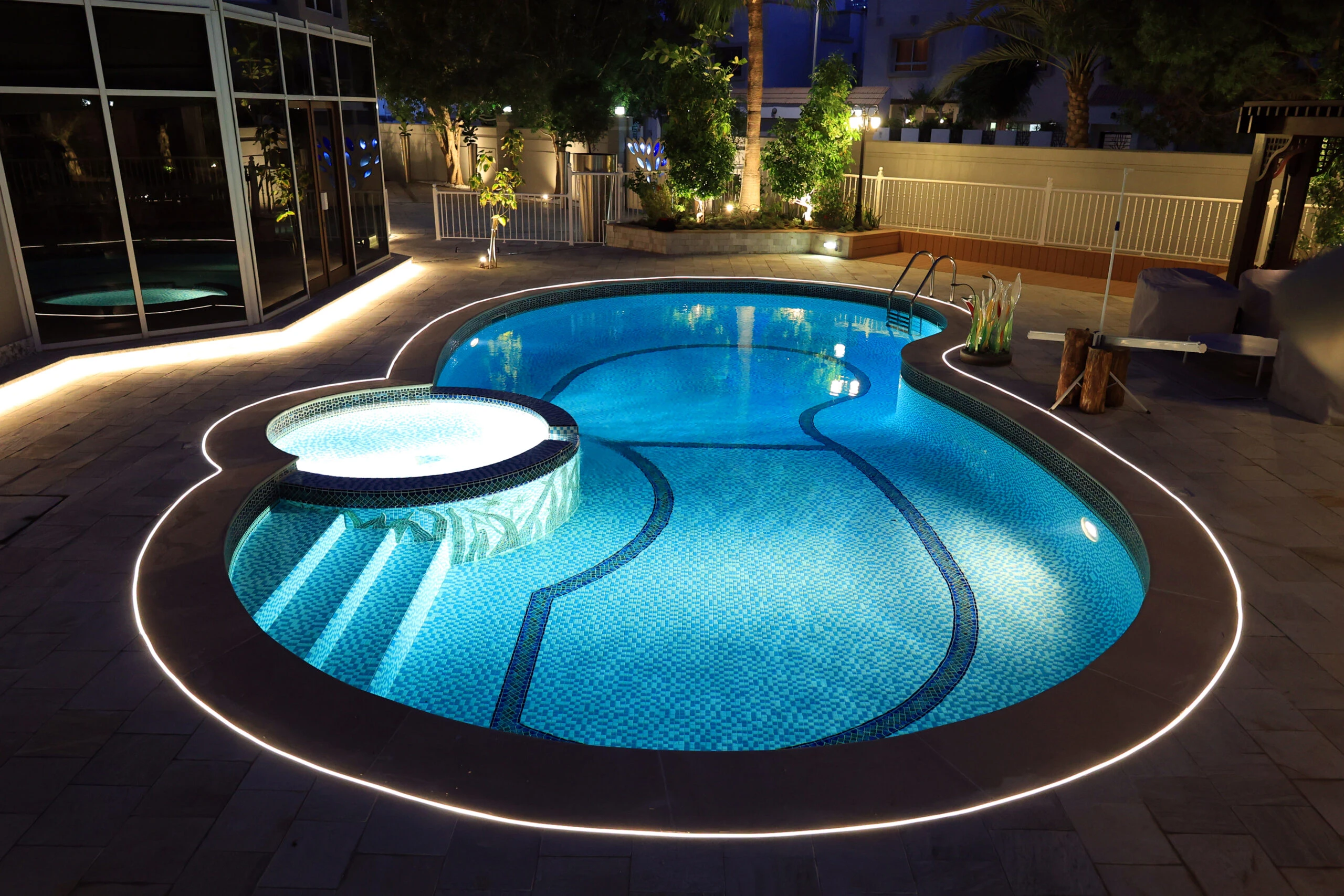Outdoor facade lighting has become a powerful tool for shaping iconic building identities. With waterproof RGB LED neon strips and DMX control, architects and designers can create dynamic, color-changing effects that transform any facade. From towering skyscrapers to boutique hotels and shopping centers, dynamic, color-changing lighting solutions are redefining building facades. Waterproof RGB/RGBW LED neon strips, especially when integrated with DMX control systems, are leading this transformation. The demand for dynamic, color-changing lighting solutions has been steadily rising, and at the forefront of this lighting revolution are waterproof RGB/RGBW LED neon strip lights, particularly when integrated with DMX control systems. This article delves into the versatility, impact, and technical intricacies of LED neon linear lights in exterior building projects, exploring their best use cases, features, and why they have become the preferred choice for designers worldwide
Why Waterproof RGB/RGBW LED Neon Strips Are Ideal for Outdoor Facades and Harsh Environments
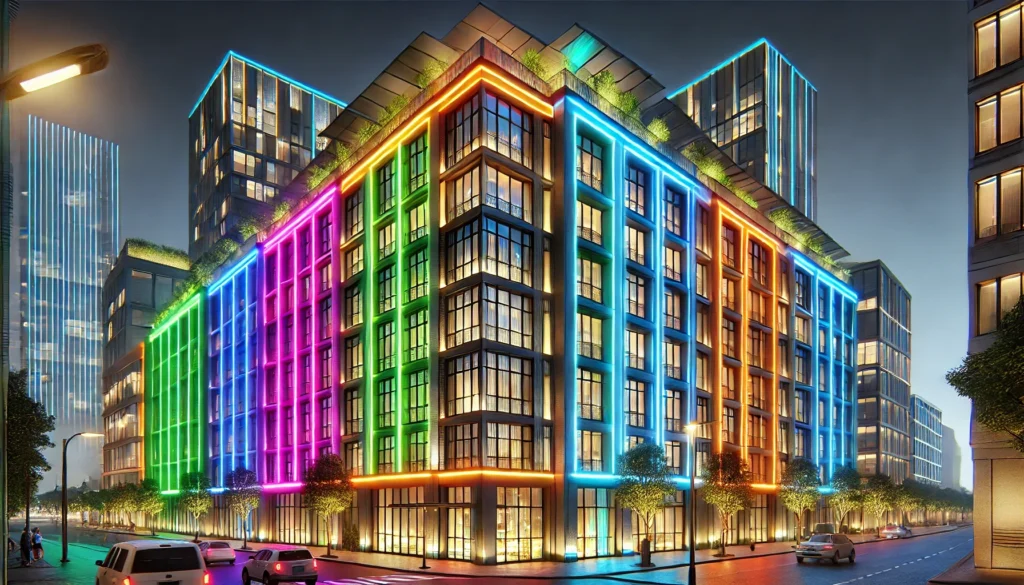
Gone are the days of relying solely on old-school glass neon tubes for outdoor lighting. The limitations of traditional neon—such as fragility, high energy consumption, and limited color options—have paved the way for the rise of LED neon strip lights. These modern alternatives offer a plethora of advantages, making them the clear frontrunner in outdoor lighting applications.
Weather – resistant construction for any outdoor environment
Outdoor environments are harsh, with elements like rain, snow, humidity, and intense sunlight constantly taking a toll on lighting fixtures. Waterproof RGB/RGBW LED neon strips are designed with advanced materials to withstand extreme conditions like rain, snow, and intense sunlight, making them perfect for coastal buildings, urban facades, and commercial applications. The use of high-quality silicone and robust casings ensures that the lights are protected from water ingress. For example, lights with an IP67 rating can be submerged in water up to 1 meter for 30 minutes without any damage. This makes them suitable for a wide range of outdoor settings—from coastal buildings constantly exposed to saltwater and sea spray to urban structures that endure heavy rain and snow throughout the year.
Unlock Creative Lighting with DMX RGB LED Neon Strips and Dynamic Color Control
DMX technology, when paired with RGB/RGBW LED neon strips, unlocks limitless creative possibilities. With DMX512 controllers, designers can create dynamic lighting sequences—transforming facades into ever-changing visual masterpieces. For instance, during a festive season like Christmas, the lights can be programmed to display a sequence of warm, festive colors with a gentle twinkling effect. During a brand launch event, the lighting can be synchronized to match the brand’s color palette, creating an immersive experience for attendees. The ability to control the intensity, speed, and direction of color changes means the lighting can be customized to suit any occasion or mood

Safe low-voltage operation (12V/24V)
Safety is a paramount concern in any lighting installation, especially in outdoor settings where people may come into close contact with the lights. Waterproof RGB/RGBW LED neon strips operate on low voltages of 12V or 24V, significantly reducing the risk of electric shock. This makes them ideal for installations in public spaces such as sidewalks, parks, and around swimming pools. Even in the event of a short circuit or damage to the lighting system, the low voltage ensures that the risk of serious injury is minimized
Vibrant RGB or RGBW color output
The RGB model creates millions of colors by combining red, green, and blue light, allowing designers to craft everything from vibrant, bold hues to soft pastels. RGBW (Red, Green, Blue, White) LED neon strips take color output a step further by adding a white light channel. This addition enables the production of high-quality white light, which is essential for applications where natural-looking illumination is required, such as in museums or art galleries. Whether creating a warm and inviting ambiance for a hotel lobby or a dynamic and energetic atmosphere for a nightclub, the color capabilities of these LED neon strips are unparalleled
Creative Lighting with DMX RGB Neon Strips
DMX (Digital Multiplex) is a communication protocol widely used in the lighting industry to provide advanced control for multiple lighting fixtures from a single controller. When integrated with RGB/RGBW LED neon strips, DMX systems open up endless possibilities for dynamic and creative lighting designs. DMX allows designers to program lighting sequences, synchronize lights with music, and adjust color intensity, speed, and direction in real time. This level of control is perfect for large-scale commercial projects, entertainment venues, and outdoor installations that require intricate, responsive lighting effects. With DMX512 controllers, lighting effects such as chases, pulses, and color transitions can be synchronized across hundreds or even thousands of LED neon strips. During special events, such as concerts, exhibitions, or brand launches, DMX-controlled lighting can match the event’s theme and mood, providing an immersive experience for the audience.
Flexible design for complex or curved structures
Modern architecture is no longer limited to straight lines and rectangular shapes. Buildings with curved facades, arched entryways, and undulating surfaces are becoming increasingly common. Waterproof RGB LED neon strips are designed to be flexible, with a silicone body that allows for a bending radius as small as 60mm. This flexibility makes them ideal for wrapping around irregular surfaces, such as the curves of a bridge railing or the edges of a circular building. They can be easily shaped to fit the unique contours of any structure, providing a seamless and aesthetically pleasing lighting solution.
Comparing RGB, RGBW, and DMX LED Neon: Which Is Right for Your Project?
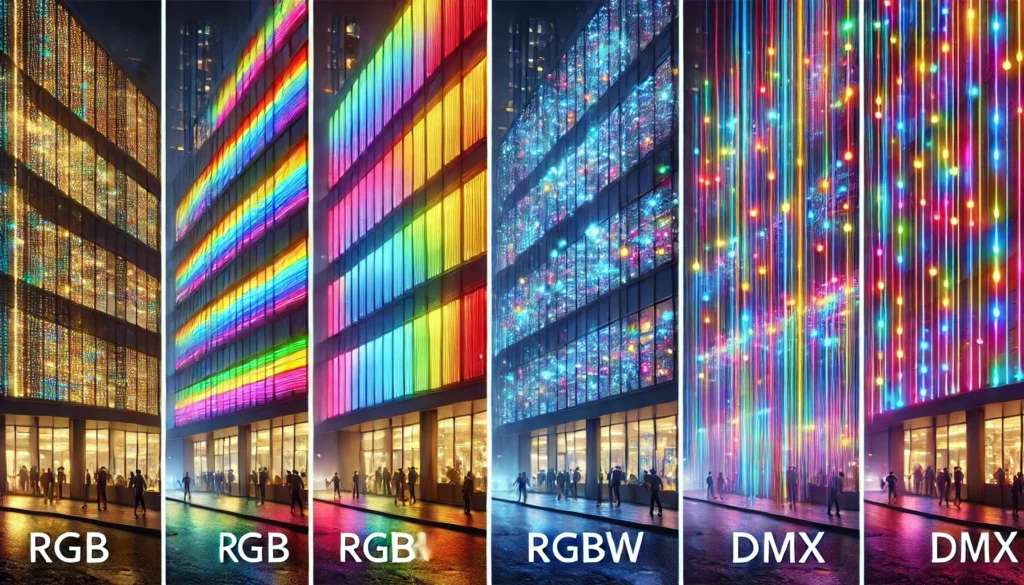
| الميزة | RGB LED Neon | RGBW LED Neon | DMX LED Neon |
| Color Control | Red, Green, Blue | Red, Green, Blue, White | Full control over RGB + White (DMX) |
| Dynamic Lighting Effects | Yes (Chases, Pulses, Color Changes) | Yes (Chases, Pulses, Color Changes) | Yes (Advanced Effects, Sync to Music, Color Sequences) |
| White Light Capability | لا يوجد | Yes (Warm, Cool, Neutral) | Yes (Customizable with White Channel) |
| Installation Complexity | Easy | Easy | Complex (Requires Controller) |
| الأفضل لـ | Retail, Residential, Events | Hospitality, Art, Retail, Residential | Professional Installations, Events, Large-Scale Projects |
| Price Range | Affordable | Mid-Range | Premium (Advanced Control) |
| Control | Basic (On/Off, Color Change) | Basic + White Control | Advanced (DMX Control, Custom Sequences) |
RGB LED neon strips are an affordable and versatile choice, perfect for vibrant color-changing effects in retail displays, home accents, and temporary events. For spaces needing both color and high-quality illumination, RGBW LED neon strips add true white light, enhancing flexibility. For more versatility, RGBW strips add true white light, perfect for spaces needing both color effects and high-quality illumination. These strips are ideal for retail spaces, residential applications, and temporary events. In retail, they can create eye-catching displays or attract attention to storefronts, while in homes, they add fun, customizable accent lighting to living rooms, kitchens, or staircases. For temporary events like trade shows or pop-up stores, RGB strips provide cost-effective, vibrant lighting that enhances the space without breaking the budget. The main advantages of RGB LED neon strips are their affordability, wide range of color options, and ease of installation. These strips offer excellent value for various applications, delivering dramatic color effects with simple controls. Whether you’re aiming to highlight products, set a mood, or create an immersive experience, RGB LED neon strips provide a versatile and budget-friendly solution.
RGBW LED neon strips are ideal for projects that need dynamic color lighting and true white light for spaces like art galleries, hospitality, and public spaces. With a dedicated white LED channel, these strips offer true white illumination, providing greater flexibility in lighting design. They’re ideal for spaces where you want vibrant colors and the ability to switch to warm or cool white light as needed. In hospitality settings like hotels, bars, and restaurants, RGBW strips can create inviting environments, with soft white lighting for a cozy ambiance or colorful effects to highlight architectural features. In art galleries and exhibitions, they offer the ability to properly illuminate artwork with true white light while still providing the option to add color effects for themes or special events. Public spaces such as event halls and shopping centers also benefit from RGBW strips, which can offer customizable lighting for thematic setups and dynamic atmospheres, with the flexibility to adjust to neutral or white light for general illumination. RGBW LED neon strips provide true white light, with the ability to adjust between warm, neutral, and cool tones, making them perfect for environments where high-quality white light is required alongside vibrant colors. Their versatility allows for a wide range of lighting solutions, enhancing flexibility and enabling accurate color rendering, especially in settings where white light needs to be a prominent part of the design.
DMX LED neon strips are the ideal solution for projects that require complex lighting designs with advanced control, sequencing, and synchronization. DMX (Digital Multiplex) is a communication protocol that enables the control of multiple lighting fixtures from a single central controller, allowing you to create intricate sequences, make real-time adjustments, and synchronize effects for an immersive visual experience. DMX LED neon strips are perfect for large-scale commercial installations such as skyscrapers, bridges, or corporate headquarters, where they can be used to achieve stunning visual effects across expansive facades or spaces. They can also be synchronized with events or specific times of day to enhance the atmosphere. In entertainment venues like concert halls, nightclubs, and theaters, DMX-controlled LED neon strips are used to create dynamic light shows that sync with music, adding drama and energy to performances. For special events or themed installations, DMX lighting provides the flexibility to create precise, tailored effects, making it an excellent choice for grand openings, brand activations, and exhibitions.
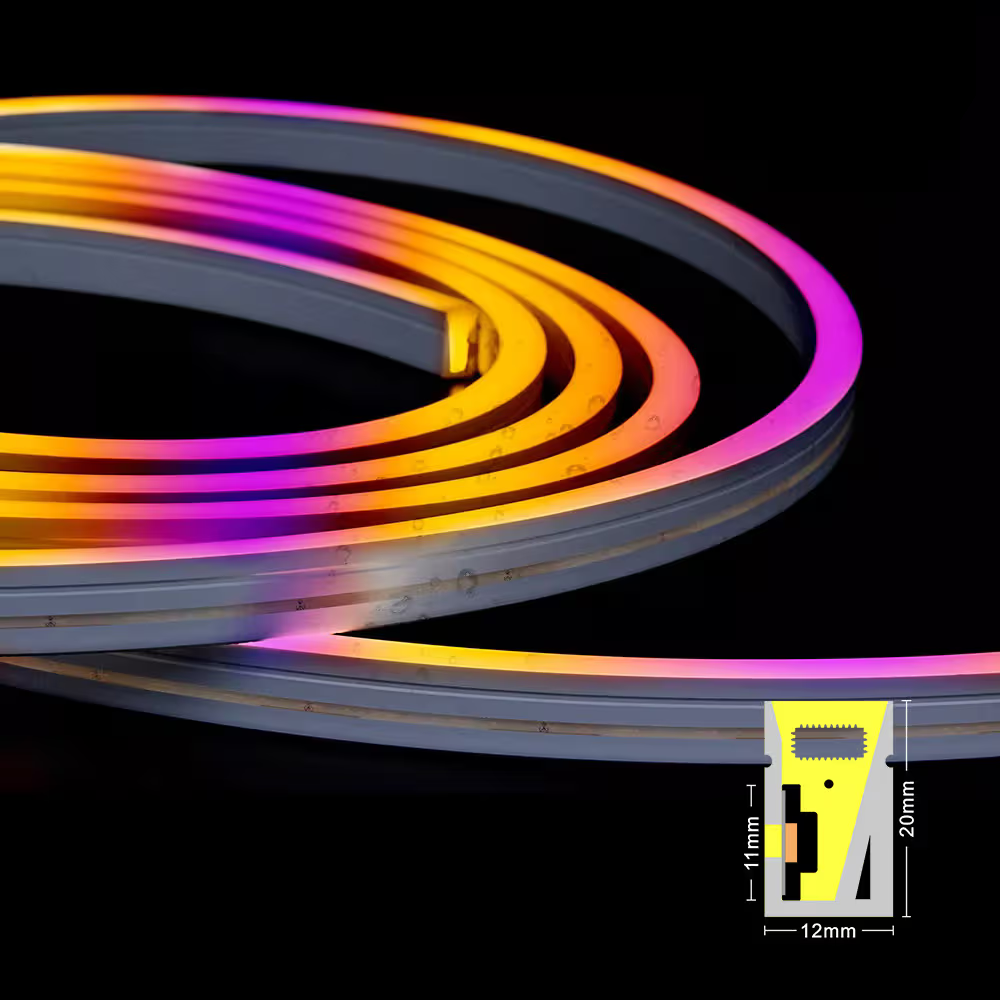
شريط نيون LED من السيليكون S1220 من سايد بيند S1220 القابل للتعديل لإضاءة الجدران والواجهات المعمارية والجدران الزجاجية والواجهات
رقم الموديل: NAA1220SC
جهد الإدخال: DC24V
واتس: 12 واط/م/متر في RGB، 19 واط/متر في RGBW
كمية الصمام الثنائي الباعث للضوء LED: SMD505050 60LEDs/متر
درجة حرارة اللون: RGB/RGBW(2700K-6500K)
نوع الإشارة: SPI/DMX512
درجة IP: IP65/IP67
إدخال الكابل: الجهة الأمامية
الحد الأدنى لقطر الانحناء: 100 مم
الطول القابل للقطع: 100 مم
الطول: 5 أمتار/لفة
The key benefits of DMX LED neon strips include advanced control, allowing for fine-tuned synchronization and custom programming, the ability to manage large-scale systems with hundreds or thousands of lights from one controller, and full customization of lighting sequences. Additionally, DMX-controlled strips can be synchronized with audio or video sources, providing a truly immersive environment for any event or installation.
Endless Design Options with RGB/RGBW & DMX Neon Lights
1. IP67 Waterproof Neon Lighting for Architecture
Buildings are constantly exposed to the elements, and their lighting systems need to be able to withstand these harsh conditions. IP67-rated waterproof neon lighting is specifically designed for architectural use. The “IP” stands for “Ingress Protection,” and the numbers 67 indicate a high level of protection. The “6” means that the light is dust-tight, preventing any dust particles from entering the fixture. The “7” indicates that it can be submerged in water up to 1 meter for 30 minutes. This level of waterproofing is crucial for building exteriors, where rain, snow, and humidity can cause significant damage to lighting fixtures over time. In addition to water protection, these lights are also resistant to UV exposure, which can cause the materials to degrade and the colors to fade. By using special UV-resistant coatings and materials, IP67-rated neon lights maintain their performance and appearance even after years of exposure to the sun.
2. RGB/RGBW + DMX = Unlimited Creative Freedom
The combination of RGB/RGBW color technology and DMX control offers designers an unprecedented level of creative freedom. DMX512 is a digital communication standard that allows for the control of multiple lighting fixtures from a single source. With a DMX controller, users can create a wide variety of lighting sequences, including:
Static or moving color gradients: A static color gradient can create a consistent and calming atmosphere, such as a soft blue glow for a spa or a warm orange light for a restaurant. Moving color gradients, on the other hand, add dynamism and energy, with colors smoothly transitioning from one shade to another.
Full-spectrum chases and pulses: Chases involve a sequence of lights turning on and off in a specific pattern, creating a moving effect. Pulses, on the other hand, are short bursts of light that can add emphasis or excitement. For example, in a concert venue, full-spectrum chases and pulses can be synchronized with the music to create a visually stunning show.
Event-specific programs (Christmas, New Year, brand launches): DMX-controlled RGB/RGBW LED neon strips can be programmed to display unique lighting effects for different events. During Christmas, the lights can be programmed to display classic holiday colors like red and green, along with twinkling stars and snowflake patterns. For a brand launch, the lighting can be customized to match the brand’s logo and color scheme, creating a memorable and immersive experience for guests.
3. Flexible Neon Strip for Curved Walls
The flexibility of LED neon strips is one of their most significant advantages, especially when it comes to curved walls and irregular surfaces. The silicone body of these strips allows for a bending radius as small as 60mm, enabling fluid design on surfaces that would be difficult to light with traditional fixtures. Some of the applications where this flexibility is particularly useful include:
Arched entryways: Arched entryways are a common architectural feature in many buildings, from historic churches to modern hotels. LED neon strips can be easily bent to follow the curve of the arch, providing both a beautiful and functional lighting effect. This not only enhances the aesthetic appeal of the entryway but also ensures visibility for people entering and exiting the building.
Undulating facades: Buildings with undulating facades, such as the Sydney Opera House or the Guggenheim Museum in Bilbao, require lighting solutions that adapt to their unique shapes. LED neon strips can be installed along these curves, creating a continuous, flowing light that highlights the architecture’s organic forms.
Cornices and signage outlines: Cornices and signage are essential elements of a building’s exterior, and lighting them can increase visibility and impact. LED neon strips can be bent to fit the contours of cornices and signage, providing bright, eye-catching illumination. This is especially useful for businesses looking to attract customers with striking signage.
4. Plug-and-Play System with Easy Installation
Installing lighting systems on large building exteriors can be a complex and time-consuming process. However, waterproof RGB/RGBW LED neon strips with a plug-and-play system simplify the installation process. These strips come in custom lengths, with pre-attached connectors and mounting tracks. This allows installers to easily cut the strips to the required length, connect them together, and mount them on the building’s facade using the provided tracks. The plug-and-play system also reduces the need for complex wiring and electrical work, making it possible for non-professional installers to complete the installation. Additionally, the use of standardized connectors and mounting systems ensures that the installation is secure and reliable, minimizing the risk of loose connections or damage to the lighting system.
How LED Neon Strips Are Changing the Lighting Landscape
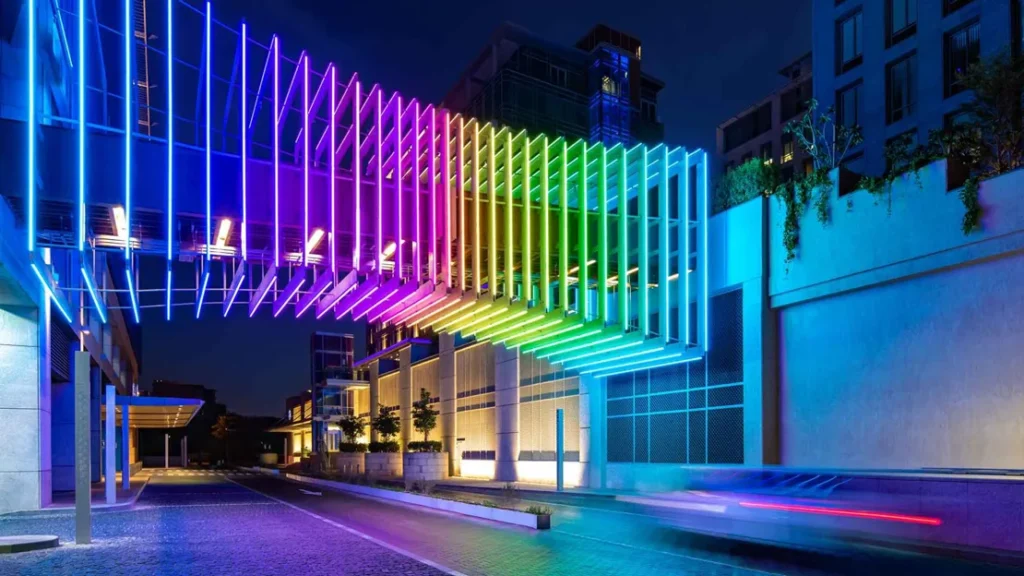
Neon Strip for Building Exteriors
High-rises, commercial towers, and hospitality facades are constantly looking for ways to stand out in a crowded urban landscape. Waterproof RGB LED neon strips offer a powerful solution for creating iconic nighttime identities. For example, in major cities like New York or Shanghai, the facades of skyscrapers can be illuminated with dynamic, color-changing LED neon strips. These lights can be programmed to display different colors and patterns depending on the time of day, the season, or special events.
During the day, the lights can be set to a subtle white or neutral color, blending with the building’s architecture. At night, they can be transformed into a vibrant display of colors, attracting attention from miles away. In the hospitality industry, hotels can use LED neon strips to create a unique and inviting atmosphere for guests. For example, a beachfront resort can use blue and green LED neon strips to create a calming, tropical ambiance, while a luxury city hotel can use warm white and gold-toned lights to exude elegance and sophistication.
Retail Storefronts & Shopping Malls
The retail industry is highly competitive, and storefronts and shopping malls are constantly looking for ways to attract customers. DMX RGB neon lights powered by DMX control offer a dynamic and interactive way to transform windows and entry zones into eye-catching displays.
For example, during the holiday season, a clothing store can use red, green, and white LED neon strips to create a festive and inviting window display. The lights can be programmed to flash and change colors, drawing in passers-by. Shopping malls can also use LED neon strips to create a cohesive and immersive shopping experience. For instance, they can install LED neon strips along corridors and in common areas, changing the colors and patterns to match the season or a specific promotion. This not only makes the shopping mall more visually appealing but also encourages customers to spend more time inside.
Bridges & Civic Architecture
Bridges and civic architecture are important public installations that require lighting solutions that are both functional and aesthetically pleasing. Waterproof DMX LED Neon Lights offer the perfect combination of durability and visibility. For example, a suspension bridge can be illuminated with LED neon strips along its cables and towers. These lights can be programmed to create a continuous, flowing light, enhancing the bridge’s structural beauty and making it more visible at night. Additionally, the use of LED neon strips can improve safety by providing better illumination for pedestrians and motorists. Civic buildings, such as town halls and libraries, can use LED neon strips to highlight their architectural features. For instance, the columns and arches of a historic town hall can be illuminated with warm white LED neon strips, creating a sense of grandeur and importance.
Cultural Buildings & Landmarks
Cultural buildings and landmarks are often rich in history and heritage, and lighting them requires a delicate balance between modern technology and preservation. Flexible LED neon strips for curved architecture are the ideal solution for these applications. For example, a historic cathedral with intricate arches and domes can be illuminated with LED neon strips that are carefully bent to fit the curves of the architecture. The lights can be set to a warm, soft color that enhances the building’s historical character without overpowering it. Additionally, the use of LED neon strips provides a more energy-efficient and sustainable lighting solution, which is crucial for preserving these cultural treasures for future generations.
Flex Neon vs Traditional LED Strips: Which Is Better for Curved Buildings?
For curved buildings, flex neon is the better option compared to traditional LED strips. Flex neon is highly flexible, designed specifically to conform to curved or irregular surfaces, making it ideal for architectural designs with pronounced curves, arches, or rounded features. Its silicone casing allows for smooth, uninterrupted light along curves, creating a seamless and modern look. Additionally, flex neon is durable, waterproof, and UV-resistant, ensuring it performs well in outdoor environments. Traditional LED strips, on the other hand, are rigid and can only bend at certain angles, which limits their use on tight curves. They may require additional mounting hardware or custom channels for installation on curved surfaces, and there can be visible gaps between the lights. While they are cost-effective and suitable for straighter surfaces or mild curves, they are not the best choice for more complex or curved installations. In summary, for projects involving curved buildings, flex neon provides the flexibility, smooth lighting, and durability needed to achieve a professional and seamless design. Traditional LED strips are better suited for simpler, straight surfaces.
Common Mistakes in DMX RGB LED Neon Projects (and How to Avoid Them)
In DMX RGB LED neon projects, precision and attention to detail are key to achieving the desired lighting effects. However, even experienced designers and installers can encounter common mistakes that can affect both the functionality and the aesthetic of the lighting installation. Below are some of the most frequent errors in DMX RGB LED neon projects and how to avoid them to ensure a smooth and successful implementation.
1. Incorrect Power Supply
Choosing the wrong power supply can lead to dimming or flickering. Always calculate total wattage and choose a power supply with at least 20-30% extra capacity.
2. Improper Wiring
Poor connections can cause power failures. Use the correct cables, secure connections, and check everything before powering up.
3. DMX Addressing Issues
Failing to properly address each light can cause synchronization problems. Ensure every light has a unique DMX address.
4. Heat Dissipation Problems
LED strips generate heat, which can affect their lifespan. Ensure proper ventilation and use heat sinks if necessary.
5. Overloading DMX Controllers
Overloading controllers with too many devices can cause failure. Check your controller’s capacity and use DMX splitters or boosters if needed.
6. Poor Lighting Effects Planning
Lack of planning can lead to disjointed lighting. Simulate effects with DMX software before installation to ensure smooth transitions and a cohesive design.
7. Ignoring Environmental Factors
Ensure your strips have the right IP rating for the environment (e.g., IP65 for outdoor use) and are UV-resistant if exposed to the sun.
8. Neglecting Maintenance
Periodic maintenance is essential for longevity. Inspect, clean, and check connections regularly.
9. Overcomplicating the Design
Keep designs simple to avoid complex control systems and ensure ease of use. Focus on key features for maximum impact.
Avoiding these common mistakes can make the difference between a successful and a frustrating DMX RGB LED neon project. By carefully considering power requirements, addressing DMX issues, ensuring proper installation, and taking into account environmental factors, you can create a lighting system that not only looks great but also operates smoothly for years to come. Whether you’re lighting a building facade, retail space, or entertainment venue, careful planning and attention to detail will ensure your project achieves its full potential.
Installation Guide: How to Mount DMX LED Neon on Facades and Walls
To install DMX RGB/ RGBW LED neon strips on facades and walls, start by carefully planning the layout and selecting the appropriate materials, including LED strips, mounting tracks, connectors, DMX controllers, and a suitable power supply. Measure and cut the neon strips according to the desired lengths, ensuring that you cut only at marked points to avoid damaging the circuits.
Next, install the mounting tracks along the marked lines on the wall, ensuring they are securely attached using screws or adhesive. Once the tracks are in place, insert the LED neon strips into them, securing them with clips or adhesive to prevent sagging. Connect the strips together using the appropriate connectors and wire them to the power supply, ensuring the power supply is sufficient to handle the total wattage of the strips.
For DMX-controlled installations, connect the strips to the DMX controller and assign unique addresses to each strip. Once everything is connected, power on the system and test the lights to ensure they are working and the effects are synchronized. Finally, secure the wiring with zip ties or clips, clean the strips to remove any dust, and check for any wear or damage during regular maintenance.
Recommended LED Neon Strip Models
S0410 | 4x10mm Side-Bend Neon Strip Light (NQX0410SX)
The S0410 is a compact and sleek neon strip light, ideal for signs and facade outlines. Its 4x10mm dimensions make it perfect for applications requiring a narrow and discreet lighting solution. For instance, it can be used to outline a business logo on a building’s facade, providing a bright, eye-catching display. The side-bend feature allows for easy installation on vertical surfaces or along structural edges. Additionally, it’s great for lightboxes, where its high brightness enhances the visibility of the content inside.
T1212 | 12x12mm Top-View LED Neon Light (NQX1212TX)
The T1212 offers balanced top-view lighting, making it a perfect choice for applications like wall edges and rooflines. Its 12x12mm size strikes an ideal balance between brightness and compactness. Installed along a wall edge, it creates a soft, inviting glow, adding elegance to the building’s exterior. When placed along rooflines, it highlights the building’s architectural features, making it more visible at night. With its outdoor-ready design, it is built to withstand harsh weather conditions without sacrificing performance.
S1220 | Horizontal Flex RGB Neon Light (NAQ1220SX)
The S1220 is a versatile RGB neon strip, known for its smooth bending action and ability to create dynamic color effects on facades. It’s ideal for producing flowing color transitions, chases, and pulses, adding energy and excitement to a building’s exterior. For venues like nightclubs or concert halls, the S1220 can be programmed to create a stunning light show that syncs with the music. Its horizontal flex design allows for easy installation on horizontal surfaces, such as balconies or parapets.
The RGB/RGBW LED neon strips not only provide dynamic lighting effects for building facades but also create unique visual identities for commercial spaces and public installations. Whether enhancing a bustling city skyline or adding charm to your hotel, retail store, or bridge, RGB LED neon strips are the perfect solution to illuminate your project. As shown in the image, the transformation is striking: adding RGB LED neon strips brings vibrancy and modernity, turning an ordinary building facade into a stunning visual statement.

Transform your building’s exterior with DMX LED Neon Light. Explore our waterproof RGB neon lights and DMX control solutions for dynamic, color-changing displays.
